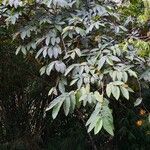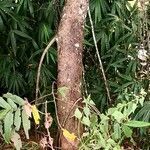Trees, 3-10 m tall, d.b.h. 15-25 cm, crown flat, spreading and umbrellalike. Bark gray, smooth. Branchlets white or brown pubescent. Stipules red, lanceolate, 2-3.5 cm, membranous, subglabrous. Leaves distichous; petiole thick, 5-10 mm, densely covered with stiff hairs; leaf blade oblong-lanceolate, strongly asymmetric, 18-28 × 9-11 cm, papery, abaxially densely covered with stiff short hairs and small yellowish brown convex spots, adaxially coarse with stiff hairs on veins, base obliquely cordate on one side and auriculate on other side, margin with small teeth or entire, apex acuminate; basal lateral veins 3 or 4 on auriculate side of leaf blade, and extending into auriculate base, secondary veins 10-14 on each side of midvein. Figs on pendulous, eventually prostrate, leafless branchlets, ± underground at maturity, solitary, reddish purple when mature, globose, 1-1.5 cm in diam., stiffly hairy; peduncle 5-10 mm; involucral bracts pubescent; lateral bracts present. Male flowers: near apical pore; calyx lobes 3, red, oblanceolate, longer than stamens; stamens (1 or)2; filaments short; anthers white. Gall flowers: calyx lobes 4 or 5, linear-lanceolate; style lateral, short. Female flowers: basal bracteole 1; calyx lobes 4 or 5; ovary ovoid-ellipsoid; style lateral, long; stigma cylindric, shallowly 2-lobed. Achenes broadly ovoid, apically slightly concave on one side, with ± small tubercles. Fl. May-Oct.
A fig. It is a tree. It grows to about 3-10 m high. The trunk is 15-25 cm across. The crown is flat and umbrella like. The bark is grey and smooth. The small branches are covered with a white or brown covering. The leaf like structure at the base of the leaves is red and sword shaped and 2-3.5 cm long. The leaf stalk is 5-10 mm long and thick. The leaves are alternate. They are 10-28 cm long by 4-12 cm wide. The are sword shaped with a long point. They have a rough texture but are papery. They have teeth in the upper half of the leaf. The base is unequal with 2 lobes. There are 10-14 secondary veins on each side of the main vein. The figs occur in pairs on short stalks on old stems. They can be clustered on leafless scaly branches. They are pear shape and with a rough texture. They are reddish-brown when ripe. They are 1-1.5 cm across.







